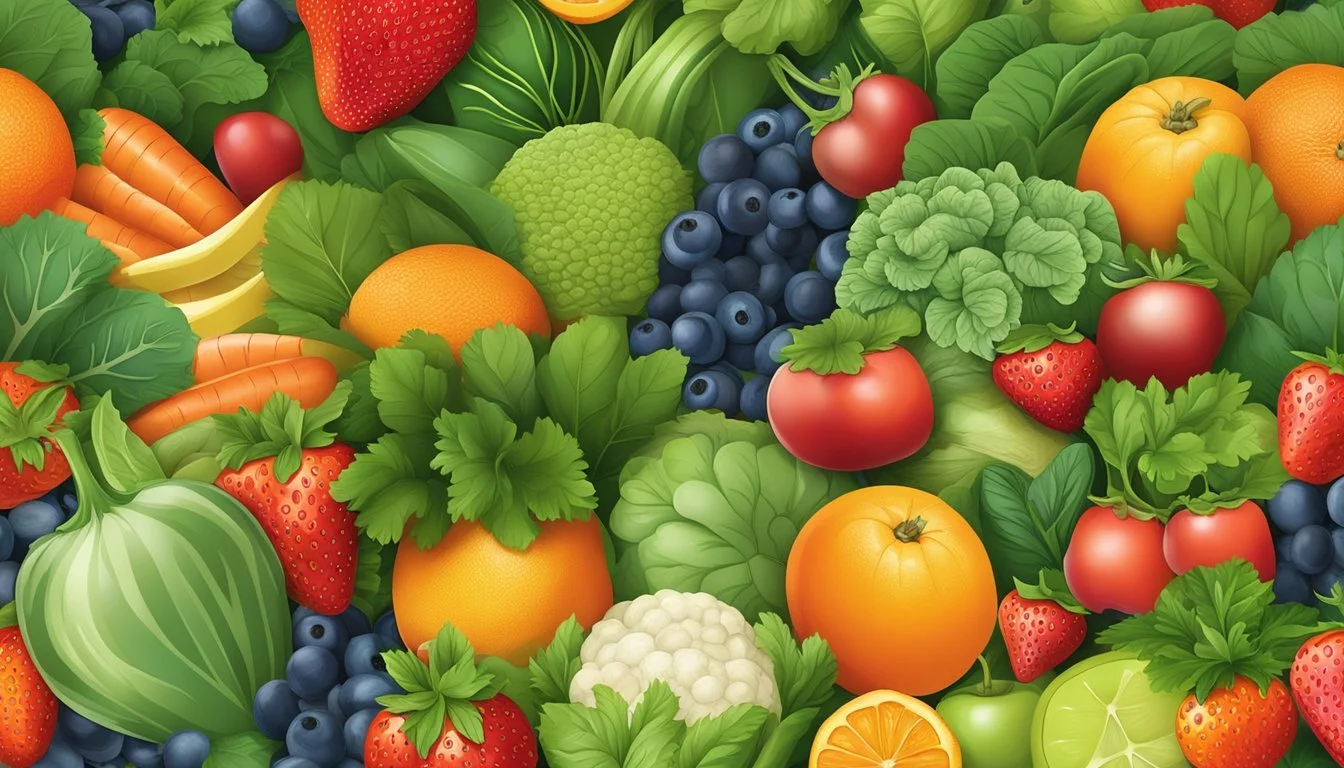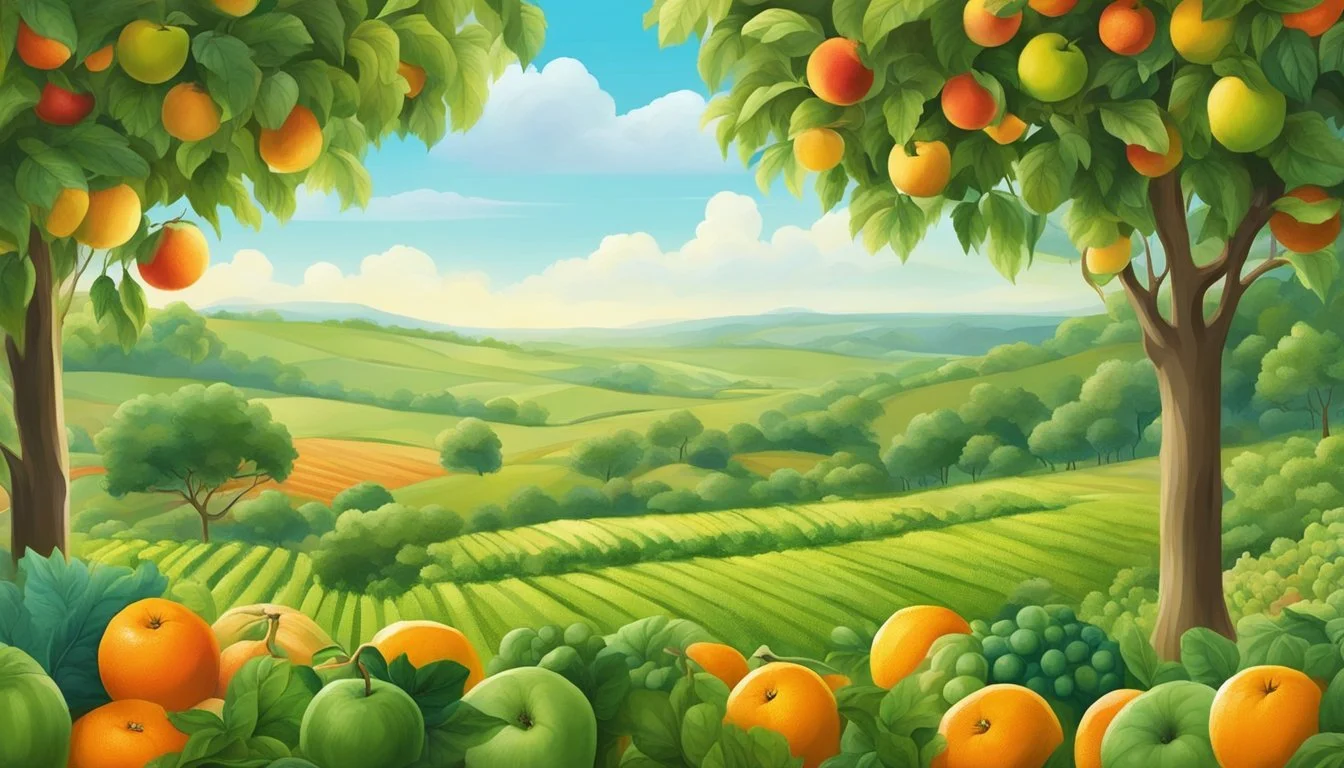Seasonal Fruit and Vegetables February
Your Guide to the Freshest Picks
This Article is Part of Our Guide to Seasonal & Local Produce in the USA
As February unfolds, the selection of fresh produce available may seem limited compared to the bountiful harvests of summer months. However, the month still offers a variety of fruits and vegetables that are at their peak during this time. Eating seasonally in February not only supports local agriculture in regions where these foods are grown, but it also ensures that consumers enjoy the freshest and most flavorful produce available. Seasonal eating aligns with the natural growing cycles and typically results in more nutritious and sustainable choices.
While some areas may still be in the grips of winter, certain hardy vegetables thrive in the cooler temperatures. Root vegetables such as beets, carrots, and parsnips, and leafy greens like kale and spinach sustain through the chilly weather and are often sweeter as the cold can convert their starches into sugars. In warmer climates, or those with controlled growing environments, you might still find a range of produce including citrus fruits such as oranges and grapefruits, which are known for their vibrant zest and are rich in vitamin C.
Understanding the seasonal availability of produce can not only improve the quality of the foods one eats but can also contribute to a more environmentally friendly and cost-effective diet. Consumers can look to February's seasonal offerings for ingredients that make hearty and warming dishes, as well as provide necessary nutrients to combat the typical winter ailments. It's a time to be creative with root vegetables and winter greens, integrating them into soups, stews, and roasted side dishes, while enjoying the occasional sweetness of in-season fruits.
What’s in Season in February in Your State?
Understanding Seasonality
Seasonality refers to the time of year when fruits and vegetables are at their peak in terms of flavor and nutritional value. This period typically corresponds with the harvest time for the produce. February is a notable month, as it falls in the heart of winter, providing seasonal produce that can withstand the cold temperature.
Winter Produce
Winter produce often includes fruits and vegetables that are hearty and can endure the colder climate. They tend to require longer growing periods and are usually harvested in the late fall to winter months. Root vegetables and citrus fruits are staples during this time. Examples include:
Citrus fruits: oranges, grapefruits, and lemons
Root vegetables: carrots, parsnips, and beets
Leafy greens: kale and spinach
Cabbages: including Brussels sprouts (how long do brussels sprouts last?) and savoy cabbage
Hardy herbs: such as rosemary and thyme
These items are often available fresh during winter, providing both vibrancy and nutrition to meals.
Why February Matters
February's significance in the seasonal calendar comes from it being a transitional period. This month bridges the last of the hearty winter produce mentioned and the early arrivals of spring. It stands as a month to enjoy the full flavors of winter's bounty before the first tender greens of spring appear. Consumers can leverage February's seasonal produce for both robust winter dishes and to prepare for lighter spring cuisines. By doing so, they not only capitalize on the taste and nutritional advantages but also often benefit from cost savings due to the abundance of in-season goods.
Nutritional Benefits of Seasonal Produce
Eating produce that's in season not only offers the freshest taste but also provides the best nutritional value, as fruits and vegetables harvested during their natural growing cycle are more likely to have a higher content of vitamins and minerals. This naturally occurring abundance helps support a balanced diet and overall health.
Vitamins and Minerals
Seasonal fruits and vegetables consumed in February are packed with a variety of vitamins and minerals essential for maintaining good health. Pumpkin, a popular choice, provides a rich source of vitamin A, which supports eyesight and immune function. Broccoli (how long does broccoli last?), another winter staple, is high in vitamin K and also provides a good amount of folate. Citrus fruits, common in winter months, are well-known for their high vitamin C content, necessary for collagen production and immune defense. Here's a snapshot of key vitamins and minerals in February's seasonal produce:
Pumpkin: Vitamin A, Vitamin C, Potassium
Broccoli: Vitamin K, Vitamin C, Folate
Citrus fruits: Vitamin C, Folate
Dietary Fiber
The fiber found in seasonal produce is crucial for digestive health. Seasonal vegetables like broccoli are high in fiber, which aids in digestion and helps maintain regular bowel movements. Fruits such as dates, enjoyed fresh or dried, offer dietary fiber that can help regulate blood sugar levels and promote satiety, which can be beneficial for weight management. Including these foods in one's diet provides the following fiber benefits:
Broccoli: Enriches gut health, contributes to satiety
Dates: Aids in blood sugar regulation, assists in proper digestive function
Consuming seasonal produce like fresh broccoli and ripe dates can significantly contribute to one’s daily fiber intake, which is a cornerstone of a healthy diet.
Seasonal Fruits
In February, the variety of seasonal fruits available tends to focus on citrus and hearty core fruits, with a selection of exotic varieties adding diversity to the winter fruit basket.
Citrus Fruits
Citrus fruits flourish in February, offering a burst of vibrant flavors and essential vitamins.
Grapefruits: They are at their juiciest, with varieties from the sweet to the tangy.
Lemons and Limes: Both are excellent for adding a fresh zest to dishes, and they remain a kitchen staple.
Blood Oranges: Noted for their deep red flesh and a flavor profile that is a mix of sweet and tart.
These citrus fruits provide a refreshing contrast to the heavier foods typically consumed during winter months.
Core Fruits
Core fruits, which include apples and pears, maintain their prominence in the market through February.
Apples: Many varieties are still crisp and sweet, perfect for both eating raw and cooking.
Pears: They offer a softer texture with a subtly sweet flavor, great for poaching or baking.
As storage techniques have improved, core fruits remain a reliable choice for those seeking fresh produce in the colder season.
Exotic Varieties
February also sees a range of exotic fruits that can offer a taste of the tropics.
Kiwis: These small fruits pack a tangy punch and a dose of vitamin C.
Persimmons: They offer a unique flavor that is both sweet and slightly tangy.
Pomegranates: Known for their jewel-like seeds and a sweet yet sharp taste.
These fruits often provide a novel ingredient for culinary experimentation and add variety to the winter fruit selection.
Rhubarb, while technically a vegetable, is often used as a fruit in culinary contexts and starts to come into season towards the end of February. It's tart and requires sweetening, and it's popular in desserts like pies and crumbles.
Seasonal Vegetables
In February, shoppers can find an array of hearty vegetables that withstand cooler conditions. Particularly prevalent are root vegetables, leafy greens, and a variety of cruciferous vegetables, each providing essential nutrients and flavors suitable for winter meals.
Root Vegetables
Root vegetables thrive in colder weather, making them a staple during February. Some key examples include:
Potatoes: A versatile vegetable used in a myriad of dishes.
Carrots: Rich in beta-carotene, ideal for both raw and cooked applications.
Sweet Potatoes: A sweeter root option, high in vitamins A and C.
Parsnips: Offering a sweet, nutty flavor when cooked.
Beets: Deeply colored, earthy vegetables known for their nutritional benefits.
Onions and Leeks: Essential for adding depth to winter soups and stews.
Celery Root (Celeriac): With a taste reminiscent of celery, excellent mashed or in soups.
Radishes: Crisp and slightly peppery, suitable for salads or roasting.
Leafy Greens
The chill of February does not inhibit the growth of certain hardy leafy greens. These include:
Kale: A nutrient-dense green, often used in salads, soups, and as a cooked side.
Spinach: Perfect for salads, spinach is also commonly used in warm dishes.
Arugula: Peppery leaves that enhance salads and pair well with citrus.
Radicchio: Adds a splash of color and a bitter edge to salads.
Collard Greens (how long do collard greens last?): Traditionally slow-cooked, providing a hearty side dish to meals.
Chicory: With a bitter taste, often used in Mediterranean cooking.
Cruciferous Varieties
Cruciferous vegetables are celebrated for their health benefits and are readily available in February:
Broccoli: Great steamed, roasted, or added to stir-fries.
Cauliflower: Can be roasted, mashed, or used as a low-carb substitute.
Brussels Sprouts: Best roasted to bring out their natural sweetness.
Cabbage: Versatile in use, from raw in coleslaw to fermented as sauerkraut.
February's seasonal vegetables embrace a natural palette capable of fostering nutritionally rich and comforting dishes through the last of winter's cold days.
Preparation and Cooking Tips
In February, utilizing seasonal produce in cooking requires knowledge of preparation techniques that enhance their natural flavors. Whether crafting a crisp salad or exploring different cooking methods, each ingredient can shine when handled with care.
Salads and Raw Dishes
Creating salads and raw dishes allows for the natural taste and texture of February vegetables to stand out. When handling greens like arugula and spinach, a gentle rinse and pat dry keeps them crisp, perfect as a base for salads. Avocados can be sliced for a creamy addition, while radishes provide a peppery crunch. A simple vinaigrette made with olive oil and a splash of vinegar can dress these ingredients without overpowering their flavors.
Cooking Techniques
For heartier fare, various cooking methods can transform February's produce into warming meals:
Roasted: Vegetables like broccoli, cauliflower, and butternut squash develop a deep, caramelized flavor when roasted with olive oil and sea salt (how long does sea salt last?) at high heat.
Soups and Stews: Slow cooking collard greens, cabbage, celeriac, and leeks in stews or soups melds their flavors and tenderizes tougher textures.
Sautéed: Quick and high-heat sautéing is ideal for bok choy and mushrooms, serving as an appetizing side dish or entree.
Desserts can also benefit from the natural sweetness of sweet potatoes or winter squash, which can be baked or pureed for pies or other treats.
Through correct preparation and cooking methods, February's seasonal produce can be transformed into delicious salads, main courses, and desserts.
Recipes and Pairings
Incorporating February’s freshest produce into meals and beverages not only maximizes flavor but also nutritional benefits. Chefs and home cooks alike rave about the adaptability of this month's seasonal ingredients in various culinary creations.
Main Courses
February offers an abundance of citrus fruits and hearty vegetables perfect for robust main courses. Chefs might recommend a Citrus-Herb Roasted Chicken, (What wine goes well with roasted chicken?) where the tanginess of grapefruits and lemons pairs beautifully with the aromatic profile of sage and other herbs. One can also find comfort in a Broccoli Cheese Pasta; the vegetable's subtle flavors complement the richness of the cheese sauce.
Recipe Example: Citrus-Herb Roasted Chicken
Main Ingredients: Chicken, grapefruit, lemon, sage.
Recipe Example: Broccoli Cheese Pasta
Main Ingredients: Broccoli, pasta, cheddar cheese, milk.
Side Dishes
Seasonal side dishes in February can be both vibrant and wholesome. A simple yet sophisticated Roasted Beet Salad with a Balsamic Reduction can serve as a refined accompaniment to any main dish. Additionally, Sautéed Kale with Garlic maintains the integrity of the leafy green while providing a healthful side option.
Recipe Example: Roasted Beet Salad with Balsamic Reduction
Main Ingredients: Beets, balsamic vinegar, mixed greens, walnuts.
Recipe Example: Sautéed Kale with Garlic
Main Ingredients: Kale, garlic, olive oil.
Smoothies and Drinks
The colder month can still bring about refreshing beverages, particularly when they’re made with in-season citrus. A Grapefruit and Tangerine Smoothie makes a refreshing breakfast option or mid-day snack, relying on the natural sweetness of the fruits. For a warmer treat, chefs might suggest a Lemon-Ginger Hot Tea, perfect for those seeking comfort from the chill of February.
Smoothie Recipe: Grapefruit and Tangerine Smoothie
Ingredients: Grapefruit, tangerine, Greek yogurt, honey.
Hot Drink Recipe: Lemon-Ginger Hot Tea
Ingredients: Lemon, fresh ginger, honey, hot water.
Buying and Storing
When purchasing fresh produce in February, buyers should focus on finding items that exhibit the qualities associated with peak ripeness and freshness, and store them in ways that maintain these qualities for as long as possible.
Selecting Fresh Produce
Fruits: For citrus fruits, such as oranges, one should look for specimens that are heavy for their size—a sign of juiciness. The skin should be vibrant and smooth, not wrinkled, which can indicate age and dehydration. Papayas should also feel heavy, and their skin should yield slightly to pressure, indicating tenderness without being overly soft.
Vegetables: Cruciferous vegetables like Brussels sprouts and broccoli should have a vivid green hue and a crisp texture. The stalks should be firm, without any slimy spots or yellowing leaves. When one selects broccoli, the florets should be tightly closed and the stalk should be hard, as softness can indicate that they are past their prime.
Storage Guidelines
Fruits: Citrus fruits and papayas should be stored in a cool place. If not consumed within a few days, they can be refrigerated to extend their freshness. One should keep them in a crisper drawer away from vegetables to prevent the ethylene gas they produce from hastening the ripening of sensitive vegetables.
Vegetables: Cruciferous vegetables should also be kept cool. Storing them in the refrigerator in perforated bags can help maintain moisture levels without creating excess that could lead to spoilage. For broccoli and Brussels sprouts, one can line the vegetable crisper with a paper towel to absorb any extra moisture and ensure a clean storage environment.
Environmental Impact
When considering the environmental implications of eating seasonal fruits and vegetables in February, two critical factors are the support of local farmers and the potential to reduce carbon footprint.
Supporting Local Farmers
Supporting local farmers through purchasing seasonal produce is beneficial for the environment. It promotes biodiversity within agriculture by encouraging crop rotation and the cultivation of a variety of plants that are native or well-suited to the local environment. In February, seasonal vegetables may include root vegetables like carrots and beets, which often come from local sources. By choosing these seasonal offerings, consumers can help reduce the need for long-distance transportation.
Reducing Carbon Footprint
The carbon footprint of food is significantly influenced by transportation. Seasonal fruits and vegetables harvested in February, such as winter squash and kale, require less energy for storage and transport when consumed locally. For example:
Transportation: Importing produce by air from distant countries contributes to higher greenhouse gas emissions. On the contrary, consuming local seasonal produce minimizes reliance on transportation, thereby reducing associated carbon emissions.
Storage: Seasonal produce is often consumed soon after harvest, reducing the need for energy-intensive storage methods that contribute to a higher carbon footprint.
Eating seasonally aligns with environmental sustainability efforts by mitigating these impacts.
Conclusion
February's seasonal offerings are a vibrant mix of citrus fruits and hearty vegetables. Consumers can enjoy the complex sweetness of blood oranges, with their stunning crimson flesh. They are not just flavorful; these fruits are packed with vitamins and antioxidants.
The month also brings an array of vegetables, including root vegetables and brassicas. They often provide an earthy flavor and are versatile in cooking. Here's a brief overview:
Fruits:
Blood oranges
Clementines
Grapefruits
Vegetables:
Beets
Cauliflower
Brussels sprouts
These items tend to be more flavorful and potentially less expensive when purchased in-season. For those seeking nutrition and taste, incorporating these seasonal products into one's diet can offer a wealth of benefits. Not only does it align with a sustainable eating approach by reducing transportation and storage impacts, but it also supports local agriculture.
Consumers should keep an eye out for freshness; for instance, carrots should be firm and bright in color. The selection may vary by region, but there's usually a good variety available.
Prepare these foods in ways that highlight their natural flavors, such as roasting or steaming. Experimenting with in-season produce can be a rewarding experience for both the palate and overall health.







